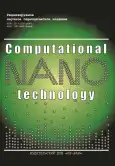Modeling of the Electrical Properties of a Solar Cell with Many Nano-hetero Junctions
- 作者: Imamov E.Z.1, Muminov R.A.2, Rakhimov R.K.3, Karimov K.N.1, Askarov M.A.4
-
隶属关系:
- Tashkent University of Information Technologies named after Muhammad al-Khwarizmi (TUIT) of the Ministry for Development of Information Technologies and Communications of the Republic of Uzbekistan
- Physical-Technical Institute of the SPA “Physics-Sun” of the Academy of Sciences of the Republic of Uzbekistan
- Institute of Materials Science of the SPA “Physics-Sun” of the Academy of Sciences of the Republic of Uzbekistan
- Karakalpak State University named after Berdakh of the Ministry of Higher and Secondary Specialized Education of the Republic of Uzbekistan
- 期: 卷 9, 编号 4 (2022)
- 页面: 70-77
- 栏目: Articles
- URL: https://journals.eco-vector.com/2313-223X/article/view/529882
- DOI: https://doi.org/10.33693/2313-223X-2022-9-4-70-77
- ID: 529882
如何引用文章
详细
全文:
作者简介
Erkin Imamov
Tashkent University of Information Technologies named after Muhammad al-Khwarizmi (TUIT) of the Ministry for Development of Information Technologies and Communications of the Republic of Uzbekistan
Email: erkinimamov@mail.ru
Dr. Sci. (Phys.-Math.), Professor; Department of Physics Tashkent, Republic of Uzbekistan
Ramizulla Muminov
Physical-Technical Institute of the SPA “Physics-Sun” of the Academy of Sciences of the Republic of Uzbekistan
Email: detector@uzsci.net
Academician, Dr. Sci. (Phys.-Math.), Professor Tashkent, Republic of Uzbekistan
Rustam Rakhimov
Institute of Materials Science of the SPA “Physics-Sun” of the Academy of Sciences of the Republic of Uzbekistan
Email: rustam-shsul@yandex.com
Dr. Sci. (Eng.); Head at the Laboratory No. 1 Tashkent, Republic of Uzbekistan
Khasan Karimov
Tashkent University of Information Technologies named after Muhammad al-Khwarizmi (TUIT) of the Ministry for Development of Information Technologies and Communications of the Republic of Uzbekistan
Email: karimov@tuit.uz
Department of Physics Tashkent, Republic of Uzbekistan
Mardon Askarov
Karakalpak State University named after Berdakh of the Ministry of Higher and Secondary Specialized Education of the Republic of Uzbekistan
Email: asqarovm@list.ru
PhD student Nukus, Republic Karakalpakstan, Republic of Uzbekistan
参考
- Rifkin J. If there is no more oil... Who will lead the global energy revolution? = The hydrogen economy: The creation of the world-wide energy web and the redistribution of power on earth. Moscow: Secret of the Firm, 2006. 416 p. ISBN: 5-98888-004-5.
- Kozlov S.I. Hydrogen energy: Current state, problems, prospects. Moscow: Gazprom VNIIGAZ, 2009. 520 p. ISBN: 5-89754-062-4.
- Kuzyk B.N., Yakovets Yu.V. Russia: The strategy of transition to hydrogen energy. Moscow: Institute of Economic Strategies, 2007. 400 p. ISBN: 978-5-93618-110-8.
- Ametistova E.V. Under the general editorship of the corresponding member. In 2 vols. Vol. 1: Fundamentals of modern energy. Prof. A.D. Trukhnia (ed.) Moscow: Publishing House of MEI, 2008. ISBN: 978-5-383-00162-2.
- Rezvanov R. Russia in the global hydrogen market // Business Economic Magazine “Invest-Foresight” (March 30, 2021).
- Imamov E.Z., Muminov R.A., Jalalov T.A., Karimov Kh.N. Ilmiy xabarnoma // Scientific Bulletin. 2019. No. 1. Pp. 25-27.
- Imamov E.Z., Muminov R.A., Jalalov T.A. et al. // Uzbek Journal of Physics. 2019. No. 3. Pp. 173-179.
- Imamov E.Z., Muminov R.A., Jalalov T.A., Karimov Kh.N. // Physics of Semiconductors and Microelectronics. 2019. No. 4. Pp. 14-21.
- Imamov E.Z., Muminov R.A., Rakhimov R.Kh. // Scientific-technical Journal (STJ FerPI). 2020. Vol. 24. No. 5. Pp. 31-36.
- Imamov E.Z., Muminov R.A. Rakhimov R.Kh. Analysis of the efficiency of a solar cell with nano-dimensional hetero transitions // Computational Nanotechnology. 2021. No. 4. Pp. 47-56.
- Ledentsov N.N., Ustinov V.M., Shchukin V.A. et al. Heterostructures with quantum dots: Production, properties, lasers. FTP. 1998. Vol. 32. No. 4. Pp. 385-410. (In Rus.)
- Prigozhin I.R., Stengers I. Time, chaos, quantum. To solve the paradox of time M., 2000.
- Haken H. Synergetics. Springer, Berlin-Heidelberg, 1997.
- Sun B., Findikoglu A.T., Sykora M. et al. Hybrid photovoltaics based on semiconductor nanocrystals and amorphous silicon // Nano Lett. 2009. Vol. 9. No. 3. Pp. 1235-1241.
- Stancu V., Pentia E., Goldenblum A. et al. // Romanian Journal of Information Science and Technology. 2007. Vol. 10. No. 1. Рp. 53-66.
- Shendrey K., Gomulya V., Yarema M. et al. Nanocrystalline PbS solar cells with high efficiency and fill factor. Appl. Phys. Lett. 2010. No. 97. P. 203501. (In Rus.)
- Tsoi B. Patent in the Eurasian Patent Office. EP2405487 A1. 30.08.2012.
- Tsoi B. Patent in the World Intellectual Property Organization. № WO 2011/040838 A2 04.07.2011.
- Gremenok V.F., Tivanov M.S., Zalessky V.B. Solar cells based on semiconductor materials. Minsk: Publishing House of the BSU Center, 2007. P. 222.
- Pikus G.E. Fundamentals of the theory of semiconductor devices. Moscow: Nauka, 1965. 448 p.
- Zimin S.P. Gorlachev E.S. Nanostructured lead chalcogenides. Yaroslavl: YarSU, 2011. 232 p. ISBN: 978-5-8397-0861-7.
补充文件










